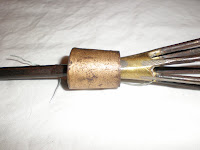
Here's a description of the first of my spearheads designed explicitly for fishing. I bought it from an eBay seller who indicated it was from Vietnam. I assumed this was the case for years, but while rummaging through my collection recently I took a closer look at the object. There's definitely a couple of characters in Thai script on the upper part of the tang (may be visible in the photo below).
These spears with numerous barbed tines arranged radially appear to be widespread across Southeast Asia and Oceania. Many (but not all) tribal fish spears have tines arranged in a circle around a central point, much like modern paralyzer points for underwater spearfishing. They work quite well, and are possibly easier to manufacture than some of the conventionally trident-type fishing spears from Europe and the western hemisphere. At their most rudimentary, such spears consist of a handful of stiff wires shoved into the reinforced end of a bamboo shaft (as in the omnipresent fish spears from Australia and the Pacific).
The item is very solidly constructed and vibrates like a tuning fork when struck. The spearhead is made from quality steel tines brazed (I assume it's brazed - the welding material is copper colored) to a square-sectioned steel tang. The barbs are crisp and neatly filed into the wires. The barbs aren't simply struck into the material with a chisel, as you see on contemporary pronged fish spears - they're expertly filed into the slightly flattened ends of the prongs. As you can see from the pictures, the prongs angle out from the base for about half their length, then end up roughly parallel to each other. The base is filed into a sleek, graceful shape and finished with a rounded shoulder.
The tang is long, with a mostly round cross-section. At the base, the tang tapers to a sharp, 4 sided point. The material is twisted 2 times, perhaps to aid screwing the tang into a bamboo shaft. The point includes a small, conical bronze-colored ferrule to slip over the end of the shaft to prevent splitting. This seems to be a common feature in Asian spears: Rather than reinforcing the shaft's socket with leather or wirework, many Asian spears (including southern Filipino budiaks and northern Filipino falfeg-type spears [and presumably continental Southeast Asian spears, but I'm not too familiar with them] incorporate metallic caps or ferrules to reinforce the shaft).

Overall, the point delicate and surprisingly graceful. The tines are made from very springy, resilient steel. I occasionally fish with hand-thrown spears, and bent tines are a constant issue - the tines on this spear are probably more likely to break than bend (which is not necessarily a positive quality), but if so, rarely. The item is not used and plenty of filework is still evident.

The item is in very good shape. Superficially, the object appears unused, with minimal patina from handling and loads of bare metal from manufacture. I suspect this was produced within the past 10-15 years by a fairly large-scale artisinal blacksmith for local use. I imagine these points are in demand by farmers seeking to add protein to their starch-heavy diet. Rice paddies are full of shrimps, small fishes and eels, and amphibians (all ideal quarry for such a light fish spear). These points would be ideal for opportunistic non-commercial spearfishing.
Length (overall): About 11 1/2" overall.
Length (blades/points): About 5 3/4" from tip of points to base.
Length (other dimensions): Tang is about 4 1/2".
Width at widest point (blade/point): Tines are about 2" across at the widest point.
Width (other dimensions): Base (section between base of points and beginning of tang) is about 1 1/4"
Materials: Spring steel (maybe heavy piano wire?).
My Thai collection is pretty limited (exactly one other item, a Vietnam-era daab sword). More on that later...


No comments:
Post a Comment